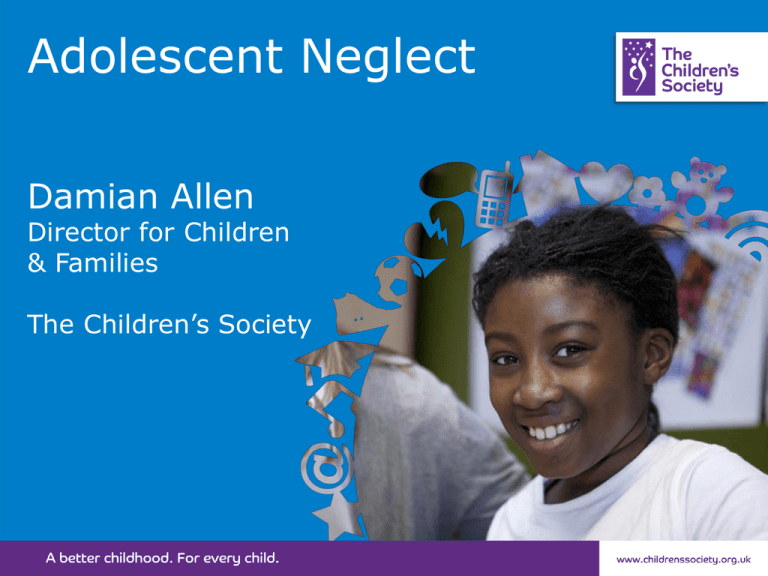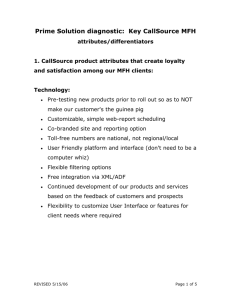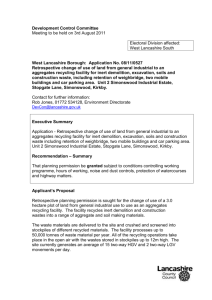Adolesent Neglect The Children`s Society
advertisement

Adolescent Neglect Damian Allen Director for Children & Families The Children’s Society Street Safe Lancashire timeline 2003: •Lancashire bid to Social Exclusion Unit short-term development fund for work with young runaways is successful for a one year pilot. •Lancashire Young Runaways Project Steering Group is set up (incorporating representatives from Police, CSC - Residential County Manager and Foster Care Manager, YPS, Connexions, TCS, LSCB Reps and others. It was the first time agencies were sitting together with the purpose of addressing and planning coordinated multi-agency responses to children MFH. These meetings grew and later progressed into becoming the LSCB Sub-group for MFH and then CSE. •First Conference on Young Runaways held in Lancashire •Two project development workers employed •Needs/resources mapping exercise across the county (in-depth interviews into professionals’ views of MFH, their duties, policies and procedures) •TCS launches Safe and Sound Campaign •(Nov) Launch of Missing From Home Pilot Scheme – Responding to every MFH incident for children in Foster Care and in three residential units (Crestmoor, Warick Avenue and The Willows) chosen due to the volume and different patterns in MFH behaviour. Return Interviews completed with follow up work and advocacy. 2004: •End of pilot external evaluation published. Reduction in two thirds of MFH incidents across the three units worked with. • (Feb) Implementation of first Joint Protocol between Lancashire Constabulary and Lancashire County Council with the support of The Children’s Society – Young People Missing from Home and Care (Later to be reviewed and to become the Pan-Lancashire Protocol) •Got 2 go – Conference on local and national developments around MFH and presenting findings from the pilot •Phase 2 of the Project is launched – due to demand, LYRP began responding to work across the whole County based on determined criteria and level of need. •Significant increase in CSE cases – struggling to get consistent responses and support 2005: •Operation Awaken is launched in Blackpool •Operation Engage is launched in Blackburn With Darwen •Still Running II is published by The Children’s Society Over 100,000 people sign The Big Safe and Sound Sign Up 2006: •Collocation between The Children’s Society and Police in F Division •Revised version of Joint Protocol is launched focusing solely on Looked After children - Young People Missing from Care •LDAAT begin funding LYRP as they recognise the links between MFH, CSE and drugs and alcohol. 2007: •Collocation between The Children’s Society and Police in C Division •Stepping Up Report published by The Children’s Society •Performance Framework for Local Authorities (NI 71) •Lancashire Young Runaways Project becomes Street Safe Lancashire by decision of the young people worked with •Safeguarding Children Who Run Away – Third Conference in Lancashire organised by The Children’s Society to promote national developments and research, raise awareness and challenge the local response to MFH and CSE 2008 -2009: •Staff down to one for most of this period due to illness. Work continued as normal across the County, with direct work, work in schools, awareness and training being delivered and supporting the emerging multi- agency teams in different parts of Lancashire. •Strategic representation maintained in County •Launch of the Young Runaways Action Plan by the Department for Education at No 10 Downing Street – Young people from Lancashire who were involved in Safe and Sound Campaign invited to the launch •Launch of the Joint protocol For Children Missing from Home and Care supported by The Children’s Society •Street Safe Lancashire mentioned as example in Statutory Guidance on Children who run away and go missing from home or care – DCSF July 2009 2010: •Team grows to three full-time members of staff 2011: •Three year post funded by Children in Need appointed (in partnership with Lancashire Partnership Against Crime, LANPAC) 2012: •First two student placements in service •New post created and staff appointed •Boys and Young Men Post appointed (three year contract from Comic Relief in partnership with LANPAC) •C Division MFH Pilot (3 months responding with Return Interviews and follow up work to children missing from home and one residential unit •PARTY SM4RTLY – 4 Days, 4 Towns, 4 buses, 4 schools - reaching over 2000 people in Lancashire with the message of how to stay safe during the festive period 2013: •When you think of CSE, How do you picture me? - Conference on boys and young men as victims and perpetrators of CSE •Writing and delivering CSE training for LSCB (for practitioners, managers and co-written e-learning module for LSCB website) •The sexual exploitation of Boys and Young men – four training sessions for professionals delivered through the year •Launch of Pennine MFH Pilot (6 month pilot responding with MFH RI and follow up work for all children and young people missing from home – not from care) •Team currently comprises of 7 members of staff and 2 social work students •10 years celebration events with the launch of young people’s work for professionals Campaigning on Adolescent Neglect “Despite the greater focus at a national level on missing children and CSE, and some examples of good practice at a local level, in too many areas responses to children who run away or go missing fall short of what is needed”. Our Strategic Approach: Fighting Injustice and Protection from Harm • A ‘golden thread’ to aggregate and integrate: – – – • Direct services, where we develop models of best practice based on what we know works, that we can quickly duplicate; Advocacy and lobbying to change the systemic systems that create harm and injustice; Campaigning to change detrimental attitudes and behaviours that lead to harm and injustice for children and young people. A programmatic approach across childhood poverty and adolescent neglect. Neglect stems from the failure of families, communities and society to meet children’s fundamental needs. It is experienced in the family, and by the failure of our wider society to fulfil its responsibilities to nurture, cherish and value children. Adolescent neglect Adolescent neglect stems from the failure of families, communities and society to meet young people’s fundamental needs. It is caused by both neglect in the family, and by the failure of the wider society to fulfil its responsibilities to nurture, cherish and value young people. National Policy Context “Government has had a tendency over the past fifteen years, and this one is no exception, to focus the majority of it time on child poverty and early years prevention, rather than adolescence and youth”. Local Policy & Practice Context “Our research into adolescent neglect showed that professional perception of teenagers as more resilient and able to cope with maltreatment, than younger children affects how cases of older children are assessed, and whether protection is offered to them”. Conclusion “A change is brought about because ordinary people do extraordinary things”. Barrack Obama











